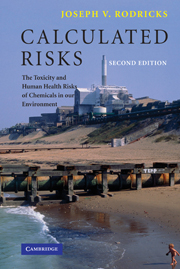Book contents
- Frontmatter
- Contents
- Preface to the first edition
- Preface to the second edition
- List of abbreviations
- Prologue
- 1 Chemicals and chemical exposures
- 2 From exposure to dose
- 3 From dose to toxic response
- 4 Toxic agents and their targets
- 5 Carcinogens
- 6 Identifying carcinogens
- 7 Risk assessment I: some concepts and principles
- 8 Risk assessment II: applications
- 9 Risk assessment III: new approaches, new problems
- 10 Risk assessment IV: the courtroom
- 11 The management of risk
- 12 A look ahead
- Sources and recommended reading
- Index
9 - Risk assessment III: new approaches, new problems
Published online by Cambridge University Press: 25 August 2009
- Frontmatter
- Contents
- Preface to the first edition
- Preface to the second edition
- List of abbreviations
- Prologue
- 1 Chemicals and chemical exposures
- 2 From exposure to dose
- 3 From dose to toxic response
- 4 Toxic agents and their targets
- 5 Carcinogens
- 6 Identifying carcinogens
- 7 Risk assessment I: some concepts and principles
- 8 Risk assessment II: applications
- 9 Risk assessment III: new approaches, new problems
- 10 Risk assessment IV: the courtroom
- 11 The management of risk
- 12 A look ahead
- Sources and recommended reading
- Index
Summary
Scientists do not enjoy resorting to defaults, not only because of their uncertain scientific foundation, but also because their use takes some of the creative work out of the conduct of risk assessment. Uncovering novel approaches to the problems of any of the several forms of extrapolation used in risk assessment, or to the problem of variability in response among individuals, and identifying the types of scientific information that might be used to implement those approaches are highly challenging endeavors. If circumstances allow their implementation in specific cases, the accuracy of risk assessments might be improved. Basing regulations and public health decisions on more accurate risk assessment results should be welcomed by all.
There are several large impediments to achieving the goal of more accurate risk assessments. First, it often requires a considerable investment in the research necessary to uncover the types of information needed to replace default assumptions in specific cases. If one hypothesizes that di-(2-ethylhexyl)phthalate (DEHP, a real and important chemical) produces liver tumors in rodents by mechanisms that either do not apply to humans at all, or that do not operate at low (human) doses, or both, then there arises the question of what type of research information is necessary to test the validity of such hypotheses? If such research is actually carried out, then what type of results from that research would allow conclusions to be drawn about the validity of the hypotheses?
- Type
- Chapter
- Information
- Calculated RisksThe Toxicity and Human Health Risks of Chemicals in our Environment, pp. 250 - 272Publisher: Cambridge University PressPrint publication year: 2006



